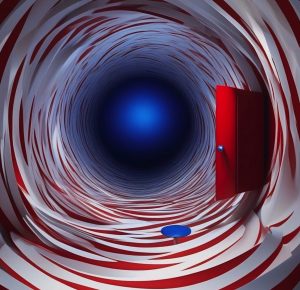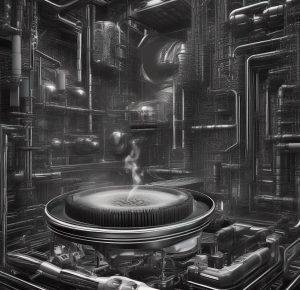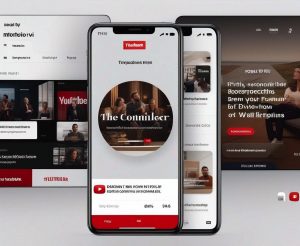The pervasive blend of floral chemicals is saturating every facet of my experiential existence. I contemplate the multitude of contents I’ve casually watched and it becomes manifest that these sensory experiences have grown into an integral part of my digital fruition. In retrospect, I realise how these videos, absorbed with casual indifference, exert a profound influence on my perception. These things that make me sleepy are remediated archaeological relics, a phenomenon rooted in the early, and now nostalgically fatigued, 21st century.
Digital synesthesia is a neurological phenomenon in which stimulation of one sensory pathway leads to involuntary experiences through another. An uncommon variant, the lexical-gustatory one, involved a reaction in which words or sounds elicited an automatic experience of taste sensations. Synesthetic experiences were typically described as automatic and involuntary, and individuals with lexical–gustatory synesthesia often reported that these taste sensations were so vivid that they could influence their overall perception of the world. Did you also have the same taste in your mouth? The word society might have flooded the mouth of a synesthete with the flavour of fried onion.
It is as if the perceptual amalgamation prompted me to regard these visual artefacts not merely as spectacles but as compositions that engage a spectrum of senses. I gaze upon a mouth framed in a nearly cinematographic shot, witnessing a character -an individual who, within the confines of my modest device, is but a simulated persona- engaging in the act of consuming soap. The deliberate choice is revealed as the camera zooms in on Dove soap boxes: extreme close-ups of the objects, mid-shots capturing the hands in motion, and in the background, only the mouth remains, artfully severed, excluding the nose from the frame. The soap is devoured with audible gusto, and in that moment, I reacquaint myself with the chemical spark igniting my taste buds. The chewing noise reverberates, guiding my senses through an exploration of taste: is the chemical essence of soap again, a synesthetic cascade of flavours on my palate.
We began to conduct experiments on virtuality without visibility when a fascinating phenomenon occurred. Researchers found that, after a few minutes of visual deprivation, approximately half of the non-synaesthetes experienced synesthesia-like precepts when exposed to sounds. It was a peculiar revelation, short-term visual deprivation had the power to reshape the delicate balance of activity across the senses, allowing one sensory modality to exert a more potent influence on another. Imagine yourself confined in a dark room for a brief period, and suddenly a sound breaks the silence, a bell ringing, perhaps. But instead of merely hearing the sound, something is there. A burst of blue or a swirl of red materialises, intertwining with the auditory experience. This occurrence lent support that digital synesthesia’s manifestation involved a nuanced modulation of the sensory activity balance, a departure from the traditional belief that synesthesia was confined to anomalous neural connections requiring prolonged developmental trajectories.

Substances like lysergic acid diethylamide were found and used to induce similar states and the exploration of altered perceptual states extended beyond sensory deprivation. Users under the effect of the lysergic acid commonly reported heightened sensory perceptions and a merging of senses, for example, when sounds are accompanied by visual phenomena or vivid colours. These states remarkably mirrored the synesthetic blending of sensory modalities observed in individuals without natural synesthesia. These chemicals were thought to impact serotonin receptors in the brain, affecting sensory processing and potentially giving rise to different synesthetic phenomena and they become widely used as a new panacea to support daily tasks. The main effect was the enhancement of crosstalk between the brain regions involved in processing different sensory inputs, so we tried to achieve the same kind of result through electrical stimulation of the affected areas and we moved to the isolation of a singular neural process. Based on digital synesthesia the development of micro interfaces was initiated.
In the comments the revelation—it’s a prank; the soap is made of chocolate.
Attention Induced Head Orgasm (AIHO)
The gradual decrease of content duration is a recognized phenomenon, while the contraction of attention span is an incontrovertible reality. However, one could argue that we haven’t actually lost the ability to pay attention but have rather gained the skill to shape new abilities in a larger technical assembly, reminiscent of the overused grand theorization of machinic assemblages. What we are doing is simply developing different directions of interactions. Attentional activity is now an out-of-fashion topic, as is the discussion of the economy of attention, which was predicated on an anthropocentric assumption of a supposed decrease in our cognitive abilities. The familiar formulation of the value of experience as intrinsic to the product is no longer worth anything, just like the space that was the supermarket in our well-being. A linear infinite. This whole idea was intertwined with the broader discourse on innovation, which, in essence, reflected a form of experiential logocentrism by modelling the creation of previous digital objects on the fallacy of a precise mode and duration of experience.
Attention to attention, we were becoming increasingly inattentive. The less attention you pay, the more content you can consume, nonconsciously. YouTube TV’s introduction of Multiview was a revolutionary feature, boasting the ability to divide your screen into four sections. The claim is that this function offers the convenience of watching up to four different channels at once, and it was convenient indeed. Content disperses, erasing the assumption that undivided attention is a prerequisite for meaningful consumption. Corecore videos were many of the products for a different mode of engagement, used as an exclusive medium for social network interactions, an acceleration of hyper-lapse techniques with a dash of visual culture history and a montage of attractions. Consumption is always impressionistic, specifically algorithmic and synaesthetic. Watching the news in core-core format can introduce a level of microlearning activity during my daily Attention Induced Head Orgasm (AIHO) sessions. Has fragmented attention fostered a new kind of cognitive synthesis?
In my years of AIHO and relaxation, or if you prefer, you can call it the Soma years, the hyperesthetic market was already being conceived. To elucidate the matter with a touch of scholarly finesse: “hyper” originates from the Greek word “huper,” meaning “over” or “beyond.” In this context, it signifies a state that surpasses or goes beyond ordinary boundaries. “Aesthetic” has its roots in the Greek word “aisthesis,” concerning perception or sensation. Here, “over” serves as an overflow, akin to excess or exaggeration, much like hyperbole. Excess of stimuli was the tautological point from which we contemplated how to appropriately stimulate ourselves. The hyperesthetic transformation of everyday products may seem extravagant from a purely functional standpoint, yet this approach was inherently motivated. Within the realm of aesthetic taste, capitalist sensualism has notably succeeded in exceeding the commodification of the Marxist subjective human sensibility concept. Hyperesthetic is dependent on material access to its own production and the neural tissue itself is the object of this dependency. No side effects, just interaction, with individuals performing a series of noisy activities on the screen. Beyond a single attentional act over a single perception that coincides with momentum, through the sophistication of machines, we have manipulated perception by making it flow out of its previous sensory boundaries.

While using a twenty-hour compilation for Attention Induced Head Orgasm (AIHO), the algorithm suggests a shorter version of 10 Tapping Triggers in 10 Seconds as the outcome of efforts to occupy an algorithmic space based on the impression. It exemplifies how digital stimulation, once based primarily on an act of attention, is simply a raw-meat stimulation repeated in small bursts of time. The stimulus-based environmental reconstruction abandoned the representation of presence, figures, icons and screens that were disappearing towards a deliberate effort into sensorial over intersubjective engagement. Like artificial aromas, which were administered by synthetically reproducing the individual notes found in natural ones, AIHO relies on its ability to evoke tingling sensations and a heightened sense of presence by replicating situations of real-time stimulation. The act of simulation becomes a form of active stimulation. A form of Quantum Cinema. The user of AIHO participates in the experiential realm in which reliance on sensory reactions replaces cognitive understanding, using stimulation as a coping mechanism, a self-help tool for deprivation of welfare. I can address an attention disorder with 60 seconds of stimulation. We are exposed to whispering and soft, gentle speech, caresses, brushing or cutting of hair, cuddles, massages, or gentle touches, empathetic or personal attention, specific sounds like tapping, scratching, rustling, sighs, lullabies, unwrapping of objects and paper and music. A non-attentional event in its small temporal occurrence or, to dust off a term from the drawer, an overproduction of affect, which is primarily nonconscious, presubjective, a-signifying, unqualified and intensive.
Virtual Lemonade
On a very hot afternoon, I connected with my friends through the lemonade-sharing platform and prepared my glass of lemonade. As I sipped on the drink, the sensor captured the RGB colour and pH value of the lemonade, encoding the information using an XML protocol for wireless transmission. My friends received the information and used the lemonade simulator to overlay different colours on plain water using an RGB LED. They delivered controlled electrical pulses on their tongues to digitally simulate varying levels of sourness. Electric taste is a unique sensation produced when the tongue is electrically stimulated. This taste was first discovered by Sulzer when he placed two different metals on his tongue and it was later hypothesised that this taste resulted from an electric stimulus flowing from one metal to the other. Humans perceive electrical stimuli as a characteristic taste; the perceptual quality can manifest reversibly and instantaneously.
Currently, we can control this information with a simple algorithmic circuit, an interactive system triggered by our consumption habits that allows taste perception to be controlled by various human-computer interactions. The widespread use of eyes and arms as controllers allowed us to determine a reality in which interactions operate through and within sensory micro-interfaces, in and out of different spaces. Biosignals and biometrics were employed before in the physical integration of our bodies through gesture and gaze technology, enabling the natural utilisation of body motion to activate data but the addition of an electrical stimulus in foods and beverages constituted a new set of information, an electrical taste, that has never been perceived before. Similarly to taste, also haptic interactions evolved from the most basic form through vibrations and signals into different forms of biomaterials directly connected to the electrical impulses of our muscles and nerves.

The neuromorphic system emerged as a tool to help us stack new spaces and sensory expansion was implemented via a dissection of stimuli so that they could be relocated onto different systems. The increased usage of DIY micro-interfaces led to the creation of several private companies charged with producing and overseeing these materials. These included Expanded Reality Ltd., Augmented Reality Inc. and Spatial Computing Corp. each dedicated to the advancement and management of neuromorphic technologies. We took the trope of the neural cable, the chamber, the biotechnical womb, the cave and the Matrix capsule, and wove it into a sophisticated material capable of delivering precise stimuli. The journey toward sensory expansion didn’t lead to an immediate disappearance of the screen but to sensory diversification.
When worn, micro-interfaces create neural resonance, tuning in to the frequencies of your cognitive and emotional landscape, our thoughts manifest as neural glyphs, intricate symbols that represent the essence of neural activity. These glyphs act as a bridge between your consciousness and the neuromorphic system, translating the subtleties of your brain into a language understandable by both you and artificial intelligence. As the signals propagate through the network, neuromorphic synapses, akin to the synaptic plasticity found in biological brains, dynamically adjust. The system learns and adapts over time, crafting a contingent Attention Induced Head Orgasm experience that evolves through neural responses. We negotiate this neural infrastructure with artificial intelligences, interpreting patterns and responding with dynamic images and adaptive environments to change our state of being.
The neural network within the neuromorphic system is a calibrated observer, recognizing and amplifying stimuli triggers in harmony with the individual’s unique composition. Gentle whispers and tapping sounds, processed through neuromorphic algorithms, resonated in perfect harmony with the rhythms of my brain. Space reacts actively, based on experience with the neuromorphic system, so the intelligent interstices involved in the creation of immersive and interactive neural environments can evolve daily. Virtual reality collapsed ten years ago, and as a result, the term simulation strictly refers to the structure’s ability to move away from ocular-driven consumption. The use of large language models and neuromorphic systems has caused the sudden disappearance of manual interaction with digital objects, no reason to push on an icon if a micro interface can pick up my input and translate it into a signal to which I can eventually add sensory and vocal instructions.
Indicators of the digital communications revolution manifest in a more ethereal and elusive way than previous revolutions. Inputs are judged not as messages to be understood or interpreted, but by their ability to evoke specific affective and somatic outputs, a feature that is measured through feedback mechanisms between the public and the developers and creators of the system. The feedback helps users identify the types of inputs most suitable for eliciting the desired output and refine their perceptual strategies accordingly. The intentional distortion of sensory experiences within the chamber, the cave, the biotechnical womb and the capsule was rooted in visual projections, the perception of space, immersive soundscapes, the boundaries of auditory understanding, haptic feedback and tactile expectations. The transition attributed to the detachment of the immaterial message from the platform in the form of stimuli, led to alternating phases of contraction and expansion of the boundaries of communication towards the complete annihilation of the spatial, leaving us with our perceptual ambiguity.
Perception evolved upon an excess of stimuli.
—
Bibliography
Harlow, A. (2030). “Hyperreal Horizons: Navigating the Post-Experience Abstraction Era.” Journal of Futuristic Perspectives, 22(4), 415-432.
Quantum, L. (2028). “Neural Alchemy: Exploring the Synthesis of Attention Induced Head Orgasm and Neuromorphic Technologies.” Future Minds Quarterly, 15(3), 278-295.
Nova, E. (2032). “Beyond Anthropocentrism: Reimagining Attentional Capacities in the Post-Cognitive Age.” Journal of Speculative Philosophy, 40(2), 201-218.
Vega, M. (2027). “Logocentrism Unveiled: Deconstructing Western Notions in the Chronopolitics of Thought.” Critical Futures Review, 18(1), 88-107.
Mirage, S. (2035). “Temporal Dissonance: The Vanishing Paradigm of Traditional Well-Being Spaces.” Journal of Experiential Sociology, 28(6), 601-618.
—
Diana Lengua is a human being who conducts speculative research on interactive dimensions, exploring emerging future scenarios in spatial computing. They hold an MA in Philosophy from the University of Milan and an MA in Culture Industry from Goldsmith University of London. Currently, she is completing her doctoral project at the University of Essex on Human-Computer Interaction, embodied internet, and situated experiences in virtual spaces.


